Fullstory
 Since 1921, the plant produces brake equipment for railway rolling stock. Over the years, created, mastered and put into production, many dozens of brake devices, most of which in theirreliability and efficiency are unparalleled. Since the advent of rail transport and to this day braking techniqueis a major component of the rolling stock.
Since 1921, the plant produces brake equipment for railway rolling stock. Over the years, created, mastered and put into production, many dozens of brake devices, most of which in theirreliability and efficiency are unparalleled. Since the advent of rail transport and to this day braking techniqueis a major component of the rolling stock.Traffic safety is directly dependent on the perfection and reliability of the brakes.
Imperfection of hand brakes made driving at high speed verydangerous. We had to limit the speed, and life was presentingcompletely different requirements. Rail transport needed newbrakes: fast, reliable, ones that can trigger the driver himself.
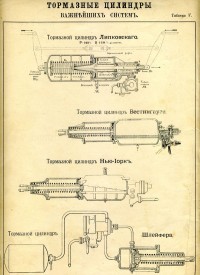 For many years, was looking for an inventive idea how to solve this problem. There were a variety of braking systems: steam, electromagnetic, mechanical, hydraulic ... However, each system had serious flaws. Some were sophisticated in design, others are uncomfortable to use, others are insufficiently reliable and flexible.
For many years, was looking for an inventive idea how to solve this problem. There were a variety of braking systems: steam, electromagnetic, mechanical, hydraulic ... However, each system had serious flaws. Some were sophisticated in design, others are uncomfortable to use, others are insufficiently reliable and flexible.Particularly widely used in automatic railroad air brake, which ismore than a hundred years ago, was patented by GeorgeWestinghouse in the United States.
 In 1921 from Orenburg was reported that a former machinist Florenti Pimenovich Kazantsev invented a new air brake, which was superior «Westinghouse» in its capabilities. Then, in Moscow in the former military plant was started producing devices of braking equipment for passenger trains. It was the birth of the Soviet establishment of brake systems.
In 1921 from Orenburg was reported that a former machinist Florenti Pimenovich Kazantsev invented a new air brake, which was superior «Westinghouse» in its capabilities. Then, in Moscow in the former military plant was started producing devices of braking equipment for passenger trains. It was the birth of the Soviet establishment of brake systems. "Westinghouse" (USA) and "Knorr-Bremse" (Germany) Companies believed that Soviet industry could not independently create and introduce a brake on the rolling stock. "Knorr-Bremse" firm suggested a parallel test of Kazantsev and Kunze-Knorr brake systems.
"Westinghouse" (USA) and "Knorr-Bremse" (Germany) Companies believed that Soviet industry could not independently create and introduce a brake on the rolling stock. "Knorr-Bremse" firm suggested a parallel test of Kazantsev and Kunze-Knorr brake systems.In December 1925, on the way down to Siam pass with slopes up to 30% Kazantsev brake showed high controllability andinexhaustibility action,Knorr-Kunze brake in the same conditionswas not enough controlled, resulting in lowering the rate varied greatly, but in the most important area, leaving the tunnel before the station Tsippa, on a slope of 28% train was ruptured in three places.
 In those days, the press noted: — "It's a holiday for us! The first case of the Soviet plant competition with the capitalist ..."
In those days, the press noted: — "It's a holiday for us! The first case of the Soviet plant competition with the capitalist ..."In the last century in an English handbook found it necessary topay tribute not only to his compatriot, but also the handyman from Russia: — "The Englishman George Stephenson gave man thesteel horse. Real reins for this steel monster taming first created the by machinist Florenti Kazantsev".
In 1926, the Commissariat of communications pathsdecided to equip freight rolling stock with Kazantsev brake and at the same time Moscow brake plant (it is our former name) began to produce diffusers.
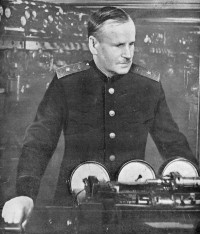 During this period, was filed about 30 proposals to improve the existing design brakes. The most promising design was machinist of the Chief north-west workshops roads Ivan Matrosov. In 1931, the Board of the Commissar of Railways had Matrosovbrake as a model for the railways of the USSR, and the tests carried out showed that it is on par with the best European brakes,but some indicators are even higher.
During this period, was filed about 30 proposals to improve the existing design brakes. The most promising design was machinist of the Chief north-west workshops roads Ivan Matrosov. In 1931, the Board of the Commissar of Railways had Matrosovbrake as a model for the railways of the USSR, and the tests carried out showed that it is on par with the best European brakes,but some indicators are even higher. Tireless work of talented inventors such as Kazantsev, Matrosov, scientists and designers Egorchenko, Karvatski, Albekov, hardcreative work of the plant staff, which constantly increasing its production volume, were allowed the railways of the country fully move to the domestic braking devices. By the beginning of the Second Five Moscow brake plant became one of the most important enterprises of the transport machinery.
Tireless work of talented inventors such as Kazantsev, Matrosov, scientists and designers Egorchenko, Karvatski, Albekov, hardcreative work of the plant staff, which constantly increasing its production volume, were allowed the railways of the country fully move to the domestic braking devices. By the beginning of the Second Five Moscow brake plant became one of the most important enterprises of the transport machinery.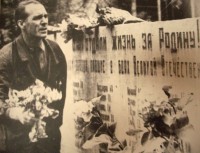 The plant never stopped working during the war years. More than 250 factory workers went to the front. Many of them died. Their names, their feats will forever remain in people's memory: theirnames are engraved on the monument to the employees of the plant, died in the battles of 1941-1945, erected at the plant in 1967.
The plant never stopped working during the war years. More than 250 factory workers went to the front. Many of them died. Their names, their feats will forever remain in people's memory: theirnames are engraved on the monument to the employees of the plant, died in the battles of 1941-1945, erected at the plant in 1967.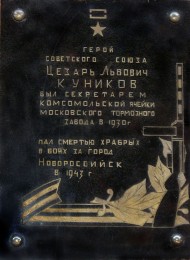 Among the warrings: Hero of the Soviet Union Kunnikov Caesar, commander of theparatroopers, Hero of the Soviet Union Konstantin Denisov, a pilot.
Among the warrings: Hero of the Soviet Union Kunnikov Caesar, commander of theparatroopers, Hero of the Soviet Union Konstantin Denisov, a pilot.General Peter Teremov began his life simply as a mechanic.
Designer Tengiz Shavgulidze, being the partisans of Belarusworked miracles. He is using the available materials, invented a simple and reliable means of fighting the enemy. Every year, on the eve of Victory Day, near the stele of war deadworkers of the plant, it is rewarded a tribute to the heroes of our country.
During the period, when enemies attacked Moscow, it was decided to evacuate the plant. Only two workshops that manufacture ammunition remained in the capital: the foundry and mechanical.
 Large industrial experience, gained workers, allowed to refocus the company on outputrequired frontage as quiqly as it was possible.
Large industrial experience, gained workers, allowed to refocus the company on outputrequired frontage as quiqly as it was possible.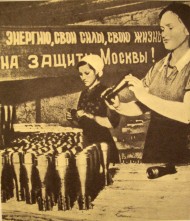 Later, many factory workers were awarded with government awards.Among them: Gnutov, Weinstein, Lamunin, Pyrkov, Kleimenov. Ilya Zazdishek and Constantine Schekotihin received the title of State Prize winners, and Vyacheslav Greaney was awarded the War Ministry. At this time, Ivan Matrosov developed and successfullyimplemented for the construction of diffusers hospital trains thatwill double the length of the trains. At the same time was created by electropneumatic auto mode for subway trains.
Later, many factory workers were awarded with government awards.Among them: Gnutov, Weinstein, Lamunin, Pyrkov, Kleimenov. Ilya Zazdishek and Constantine Schekotihin received the title of State Prize winners, and Vyacheslav Greaney was awarded the War Ministry. At this time, Ivan Matrosov developed and successfullyimplemented for the construction of diffusers hospital trains thatwill double the length of the trains. At the same time was created by electropneumatic auto mode for subway trains.Under the peacefull sky.
The war ended and the collective of our brake plant workers began peaceful constructive work. This work has been connected with many serious difficulties. There was a shortage of raw materials and equipment, logistics had not been established, the equipment in many workshops was outdated, there was a shortage of skilled workers. But factory workers, showing, as before, creativity and ingenuity, were able to mobilize internal resources to rebuild the work in new ways.
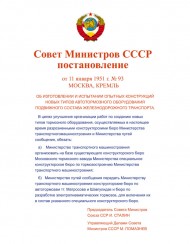 The problem of increasing weight of freight trains and speed increasing has gained special urgency. To create new systems of automatic brakes and its implementation into production, we organized sereouse researching works. Realizing the importance of braking systems for rail transport, the Government adopted a decree of the establishment at the Moscow factory brake the Special Design Bureau of the brakestructure. Along with Matrosov well-known designers and specialists worked at the factory, such as Borowski, Greeney, Krylov, Shavgulidze, Bunakov, Kozyulin, Loskutov, Smelov ...
The problem of increasing weight of freight trains and speed increasing has gained special urgency. To create new systems of automatic brakes and its implementation into production, we organized sereouse researching works. Realizing the importance of braking systems for rail transport, the Government adopted a decree of the establishment at the Moscow factory brake the Special Design Bureau of the brakestructure. Along with Matrosov well-known designers and specialists worked at the factory, such as Borowski, Greeney, Krylov, Shavgulidze, Bunakov, Kozyulin, Loskutov, Smelov ...In these years developed and strengthened community with specialists avtobrake Department Research Institute of Railway Transport. The railways developed and implemented a continuous automatic train stop, MTZ cargo diffuser type, diffuser for passenger trains.
Based on the design of Matrosov a lot of new instruments was developed. Among them, the diffuser 483 for freight cars, featuring a good performance characteristics and high reliability. Equipping trains with these diffusers allowed to drive a heavy trains over 42 tons. This device is compared favorably against foreign productsoperability at high temperature and high-speed distribution of the braking waves.
In the early 70's association was formed for the production ofbrake equipment, which included Moscow, Pervomaysky and Belevsky brake plants.
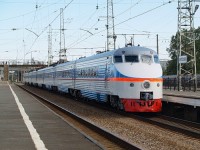 During these years, the Moscow and the Pervomaisky factories jointly developed braking system for the first domestic high-speed trains of the RT and ER-200.
During these years, the Moscow and the Pervomaisky factories jointly developed braking system for the first domestic high-speed trains of the RT and ER-200. In 1993, our factory has been transformed into joint-stock company "Transmash", the products of which are stillcharacterized by simplicity of design and high operationalreliability. Developed and produced products are protected by copyright certificates from Russian patents and patents in foreign countries.
At the plant people have always paid serious attention to technical education. The first factory training school in the Soviet Union was opened at the factory. There was also opened engineeringcollege. More than 2,000 people have received basic training.
There was conducted an intensive house-building. More than 500 families havecomfortable housing.
 With the direct participation of the Russian Federation Ministry of Railways Association was established producers and consumers of braking equipment "ASTO" with the participation of such major manufacturers as PMT "Uralvagonzavod", ВНИИЖТ, МГУПС(МИИТ) и ВНИИВ.
With the direct participation of the Russian Federation Ministry of Railways Association was established producers and consumers of braking equipment "ASTO" with the participation of such major manufacturers as PMT "Uralvagonzavod", ВНИИЖТ, МГУПС(МИИТ) и ВНИИВ.In the scientific-technical council of the association includes all the leading specialists and scientists in Russia in the field of brake technology.
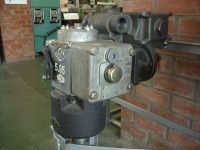 We have established fruitful cooperation with the German company "Knorr-Bremse". Our experts in collaboration with a member of the Russian Academy of Sciences Inozemtsev and German counterparts in 1995, developed a brake system with diffusers 483 KE 410 for the International trains to communication such as "East-West".
We have established fruitful cooperation with the German company "Knorr-Bremse". Our experts in collaboration with a member of the Russian Academy of Sciences Inozemtsev and German counterparts in 1995, developed a brake system with diffusers 483 KE 410 for the International trains to communication such as "East-West".This instrument eventually will be operated by rolling stock, tradedon international routes in Europe, Asia and Africa.
Thanks to a clear response to railway, subway and factory customer demands, who manufactur rolling stock, and the development of international economic relations over the past five years, MTZ TRANSMASH:
— Increased commodity output by 5 times;
— Increased the average salary is 4 times;
— Number of jobs increased by 21%.
 Creating an enterprise research base allowed a breakthrough in the field of brake systems of rail transport and subways.
Creating an enterprise research base allowed a breakthrough in the field of brake systems of rail transport and subways.Invention is the face and life of the plant and its prospect. In our factory more than 250 inventions are protected by copyright certificates and patents. All major products are based on the inventions covered by protective documents.
